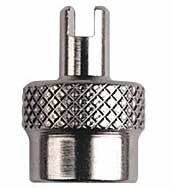Tyre maintenance is a fairly simple, but ongoing, process. Start by checking the tyre pressures weekly. The tyres should be cold, or if you've just ridden the bike, wait at least an hour before checking them. Tyres are designed to be run at a specific pressure in order to maintain the optimum contact patch. Underinflated tyres result in poorer fuel economy and reduced tyre life. Overinflated tyres wear out more quickly in the centre and can adversely affect handling.
Also inspect the entire tread surface weekly. With the bike on its centre stand the rear tyre is fairly easy to inspect. (In order to check the front tyre, I place a trolley jack under the sump, cushioned with a rubber pad, and jack up the bike just enough so that the front tyre can be freely rotated).
The legal limit of tyre tread depth in the UK for motorcycles over 50cc is 1mm across 3⁄4 of the width of the tread pattern, and with visible tread on the remaining quarter. Legal requirements may differ in other countries. It is recommended to consider replacing motorcycle tyres in advance of the legal requirement i.e. when the tread depth has reached 2mm.
Check for and remove any stones or embedded bits of glass from the sipes (the small slits in the tread blocks). If left in place, they could embed themselves further and puncture the tyre. Also check for any cracks in between the tread blocks, and look for any damage to the side wall.
The valve stem should be covered with a cap to prevent dust ingress. Metal valve caps are available which have an integrated Schrader valve key:
These are useful for tightening the valve core should it become loose. A simple test for a loose valve core is to wipe some saliva across the valve opening. If a bubble forms, the core is loose, and the tyre will gradually lose pressure.

